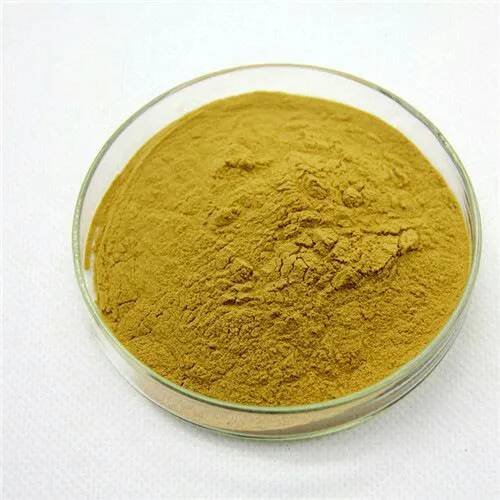- 0086-571-85302990
- sales@greenskybio.com
Echinacea Extract: From Leaves to Extraction.
2024-11-14

1. Introduction
Echinacea is a well - known plant in the field of natural remedies. Echinacea Extract has gained significant attention due to its potential health benefits. The process of obtaining this extract from the leaves is a complex yet fascinating one. Understanding this process is crucial for both producers and consumers alike, as it can directly impact the quality and effectiveness of the final product.

2. The Importance of Echinacea Leaves
2.1. Source of Active Compounds
Echinacea leaves are a rich source of various active compounds. These include alkamides, polysaccharides, and flavonoids. These compounds are believed to be responsible for the plant's medicinal properties. For example, polysaccharides are thought to play a role in enhancing the immune system, while flavonoids may contribute to its antioxidant effects.2.2. Optimal Harvesting Time
The time of harvesting echinacea leaves is of utmost importance. Harvesting at the right time ensures that the leaves contain the highest concentration of active compounds. Generally, echinacea is harvested when the plant is in its flowering stage. At this time, the leaves have had sufficient time to develop and accumulate the necessary substances. If harvested too early, the leaves may not have fully developed their active components. On the other hand, if harvested too late, some of the valuable compounds may start to degrade.
3. The Extraction Process
3.1. Pre - extraction Preparation
Once the echinacea leaves are harvested, they need to be properly prepared for extraction. This includes cleaning the leaves to remove any dirt, debris, or other contaminants. After cleaning, the leaves are often dried. Drying helps to preserve the leaves and also makes the extraction process more efficient. Different drying methods can be used, such as air - drying or using a dehydrator. However, care must be taken to ensure that the drying process does not cause excessive heat damage to the leaves, as this could potentially degrade some of the active compounds.3.2. Modern Extraction Techniques
- Solvent Extraction: One of the most common methods is solvent extraction. In this process, a suitable solvent is used to dissolve the active compounds from the echinacea leaves. Ethanol is often a preferred solvent as it is effective in extracting a wide range of compounds and is relatively safe. The leaves are soaked in the ethanol solution for a specific period of time. During this time, the active compounds in the leaves gradually dissolve into the solvent.
- Supercritical Fluid Extraction: Another advanced technique is supercritical fluid extraction. This method uses a supercritical fluid, typically carbon dioxide. Supercritical carbon dioxide has unique properties that make it an excellent solvent for extracting echinacea compounds. It has a high diffusivity and low viscosity, which allows it to penetrate the plant material easily and extract the desired compounds efficiently. Moreover, it is a "green" extraction method as carbon dioxide is non - toxic and can be easily removed from the final product, leaving no solvent residue.
- Microwave - Assisted Extraction: Microwave - assisted extraction is also being increasingly used. This technique utilizes microwaves to heat the echinacea leaves and the solvent simultaneously. The microwaves cause the plant cells to rupture more easily, which in turn accelerates the release of the active compounds into the solvent. This method can significantly reduce the extraction time compared to traditional methods.
3.3. Influence of Factors during Extraction
- Temperature: Temperature plays a crucial role in the extraction process. Different compounds have different solubility characteristics at various temperatures. For example, some compounds may be more soluble at higher temperatures, while others may degrade at elevated temperatures. Therefore, finding the optimal temperature is essential for obtaining a high - quality Echinacea Extract. In solvent extraction, if the temperature is too high, the solvent may evaporate too quickly, and some of the volatile compounds in the echinacea may be lost. In supercritical fluid extraction, the temperature needs to be precisely controlled to maintain the supercritical state of the fluid.
- Pressure: In methods such as supercritical fluid extraction, pressure is another important factor. The solubility of compounds in a supercritical fluid is highly dependent on pressure. By adjusting the pressure, it is possible to selectively extract different compounds from the echinacea leaves. Higher pressure generally increases the solubility of the compounds, but it also requires more sophisticated equipment and careful operation to ensure safety.
- Extraction Time: The length of the extraction time also affects the quality and composition of the final extract. If the extraction time is too short, not all of the active compounds may be fully extracted. However, if the extraction time is too long, there is a risk of extracting unwanted compounds or causing degradation of the desired ones. For example, in solvent extraction, leaving the leaves in the solvent for an extended period may lead to the extraction of some non - beneficial substances or the breakdown of some of the key active compounds.

4. Quality Control of Echinacea Extract
4.1. Analytical Methods
To ensure the quality of echinacea extract, various analytical methods are employed. High - Performance Liquid Chromatography (HPLC) is commonly used to analyze the composition of the extract. HPLC can separate and identify different compounds in the extract, allowing producers to determine the concentration of key active components. Another method is Gas Chromatography - Mass Spectrometry (GC - MS), which is useful for analyzing volatile compounds in the extract. These analytical techniques help to verify that the extract contains the expected compounds in the appropriate amounts.4.2. Standardization
Standardization of echinacea extract is essential for ensuring consistent quality. This involves setting specific standards for the content of key active compounds. For example, a particular echinacea extract may be standardized to contain a certain percentage of alkamides. Standardization helps to ensure that consumers receive a product with reliable and predictable medicinal properties. It also enables producers to compare different batches of extract and maintain a consistent level of quality throughout the production process.
5. The Health Benefits of Echinacea Extract
5.1. Anti - inflammatory Effects
Echinacea extract has been studied for its anti - inflammatory properties. The active compounds in the extract, such as flavonoids and polysaccharides, are thought to inhibit the production of inflammatory mediators in the body. This can potentially help in reducing inflammation associated with various conditions, such as arthritis. Inflammation is a natural response of the body to injury or infection, but chronic inflammation can lead to a variety of health problems. By reducing inflammation, echinacea extract may contribute to improving overall health.5.2. Antioxidant Effects
Antioxidants play a vital role in protecting the body from oxidative stress. Echinacea extract contains antioxidant compounds that can scavenge free radicals in the body. Free radicals are unstable molecules that can cause damage to cells, proteins, and DNA. By neutralizing these free radicals, the antioxidant compounds in echinacea extract can help prevent cellular damage and reduce the risk of various diseases, including cancer and heart disease.6. Conclusion
The process of obtaining echinacea extract from its leaves is a multi - step and carefully controlled process. From the harvesting of the leaves at the optimal time to the application of modern extraction techniques and strict quality control measures, every step is crucial in ensuring the production of a high - quality extract. The health benefits associated with echinacea extract, such as its anti - inflammatory and antioxidant effects, further emphasize the importance of proper extraction methods. By understanding this entire process, from leaves to extraction, we can better appreciate the value of echinacea in the realm of natural remedies and the potential it holds for improving human health.
FAQ:
What is the significance of harvesting echinacea leaves at the optimal time?
The optimal time of harvesting echinacea leaves is crucial as it helps to preserve their potency. If the leaves are harvested too early or too late, their active compounds may not be at their peak levels. This can affect the quality and effectiveness of the echinacea extract obtained from them.
What are the modern extraction techniques used for echinacea extract?
Some modern extraction techniques for echinacea extract include supercritical fluid extraction, solvent extraction, and microwave - assisted extraction. Supercritical fluid extraction uses a fluid at a supercritical state (e.g., carbon dioxide) to extract the active compounds. Solvent extraction typically involves the use of organic solvents like ethanol or methanol. Microwave - assisted extraction uses microwave energy to enhance the extraction process, which can be more efficient and time - saving.
How do temperature and pressure affect the quality of echinacea extract during extraction?
Temperature and pressure are important factors during the extraction of echinacea extract. High temperature may cause the degradation of some heat - sensitive active compounds in echinacea, reducing the quality and effectiveness of the extract. Appropriate pressure can help to ensure the efficient extraction of compounds. If the pressure is too high or too low, it may lead to incomplete extraction or the extraction of unwanted substances, thus affecting the composition and quality of the final product.
What are the anti - inflammatory and antioxidant effects of echinacea extract?
The anti - inflammatory effects of echinacea extract may be due to its ability to inhibit certain inflammatory mediators in the body. It can interact with the immune system and reduce inflammation at the cellular level. Regarding antioxidant effects, echinacea extract contains compounds such as phenolic acids and flavonoids, which can scavenge free radicals in the body. These free radicals are often associated with oxidative stress and various diseases, and by neutralizing them, echinacea extract can contribute to overall health.
Why is it important to study the journey from echinacea leaves to extraction?
Studying the journey from echinacea leaves to extraction is important because it helps us understand how to maximize the benefits of echinacea. By knowing the proper harvesting time of the leaves and the optimal extraction methods, we can ensure that the echinacea extract obtained has the highest quality and potency. This knowledge also allows us to better appreciate the value of echinacea in natural remedies and how different factors during the process can impact its effectiveness.
Related literature
- Echinacea: A Review of Its Role in Immunomodulation and Anti - Inflammatory Activity
- Extraction and Analysis of Bioactive Compounds from Echinacea
- The Optimal Harvesting Time of Echinacea for Maximum Extract Potency
- ▶ Hesperidin
- ▶ Citrus Bioflavonoids
- ▶ Plant Extract
- ▶ lycopene
- ▶ Diosmin
- ▶ Grape seed extract
- ▶ Sea buckthorn Juice Powder
- ▶ Fruit Juice Powder
- ▶ Hops Extract
- ▶ Artichoke Extract
- ▶ Mushroom extract
- ▶ Astaxanthin
- ▶ Green Tea Extract
- ▶ Curcumin
- ▶ Horse Chestnut Extract
- ▶ Other Product
- ▶ Boswellia Serrata Extract
- ▶ Resveratrol
- ▶ Marigold Extract
- ▶ Grape Leaf Extract
- ▶ New Product
- ▶ Aminolevulinic acid
- ▶ Cranberry Extract
- ▶ Red Yeast Rice
- ▶ Red Wine Extract
-
Licorice Root Extract Powder
2024-11-14
-
Saw Palmetto Extract
2024-11-14
-
Okra Extract
2024-11-14
-
Phellodendron Extract
2024-11-14
-
Panax Ginseng Leaf Extract
2024-11-14
-
Lemon Extract
2024-11-14
-
Tamarind extract powder
2024-11-14
-
Ivy Extract
2024-11-14
-
White Peony Extract
2024-11-14
-
Maca Extract
2024-11-14





















